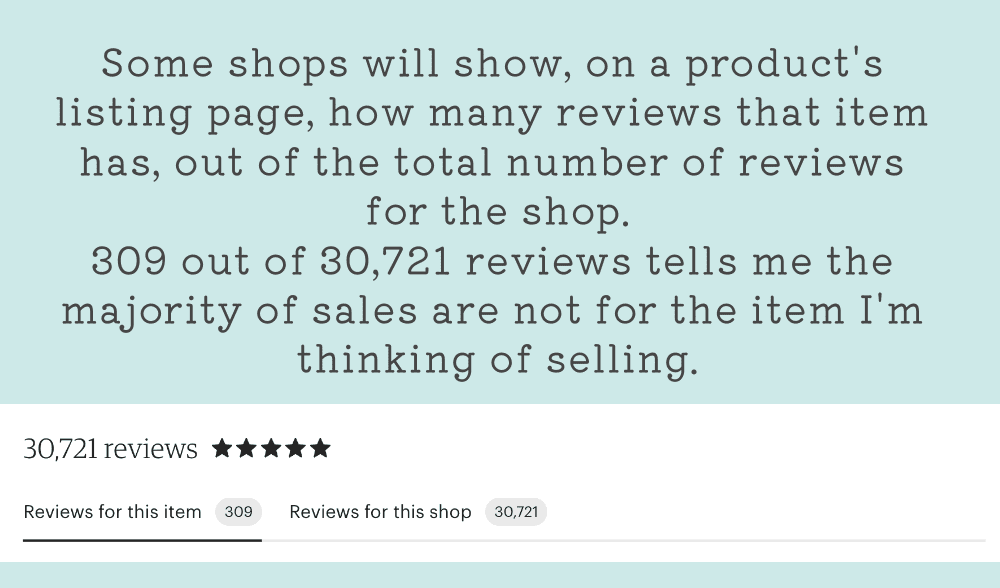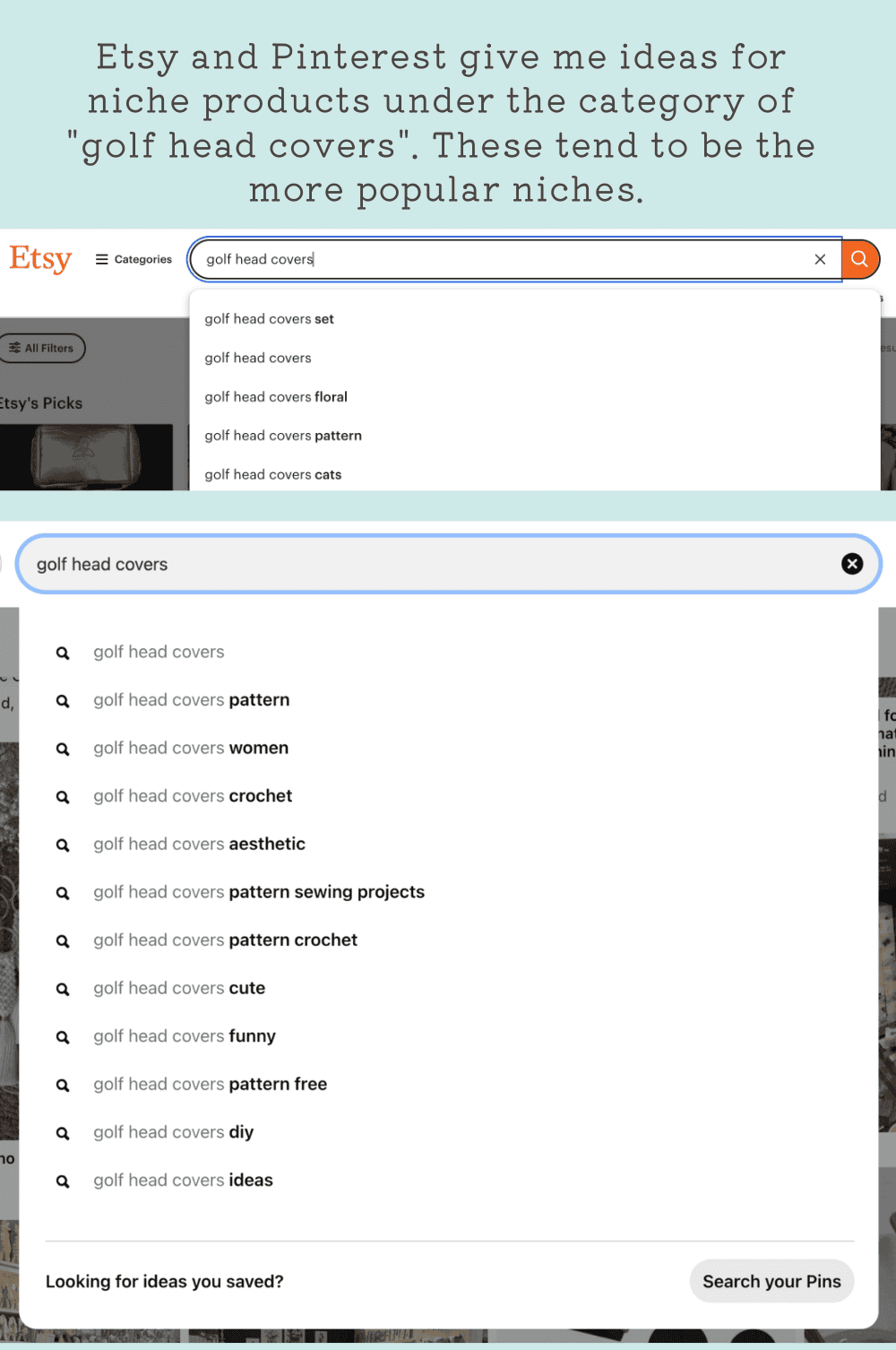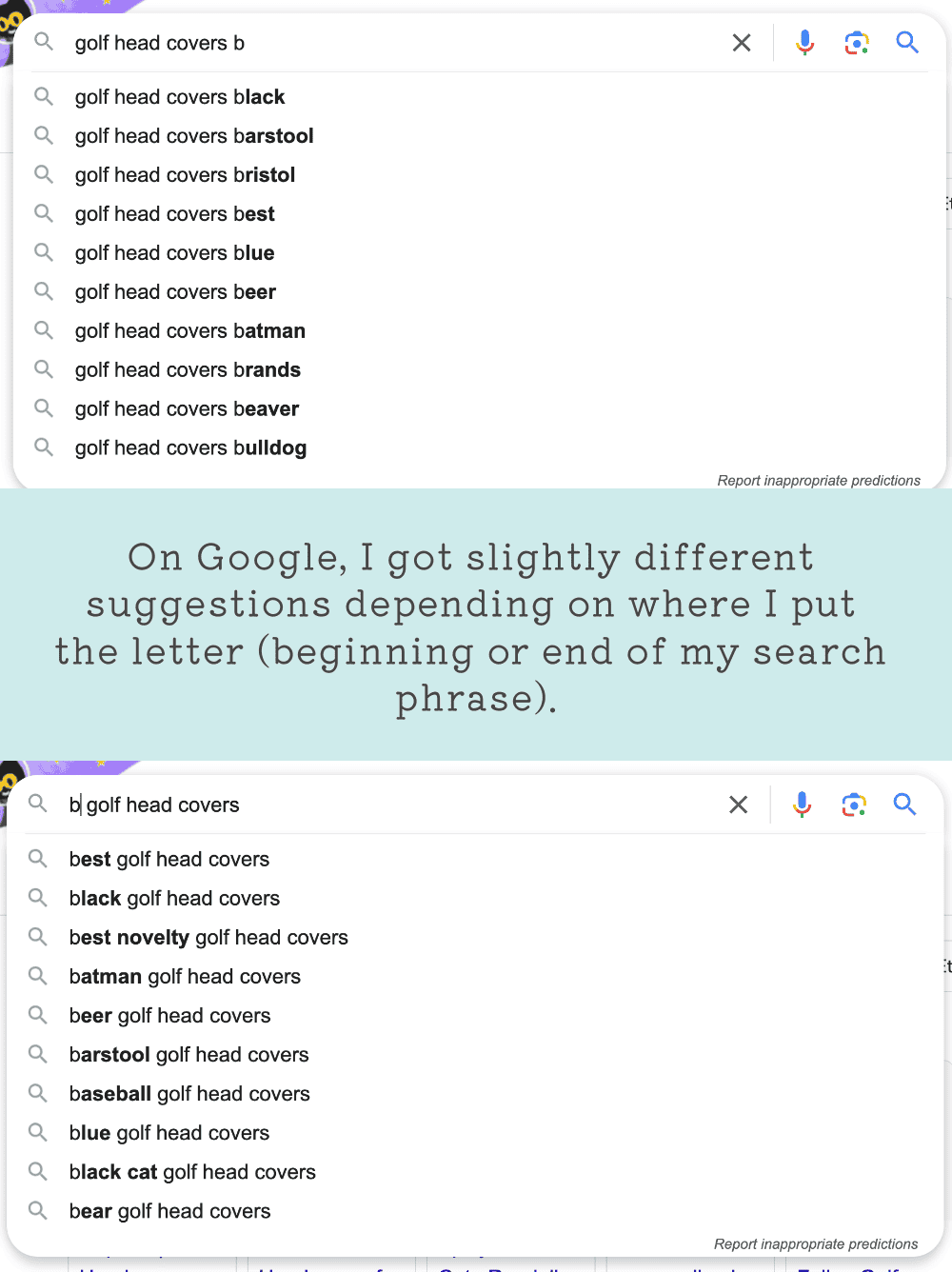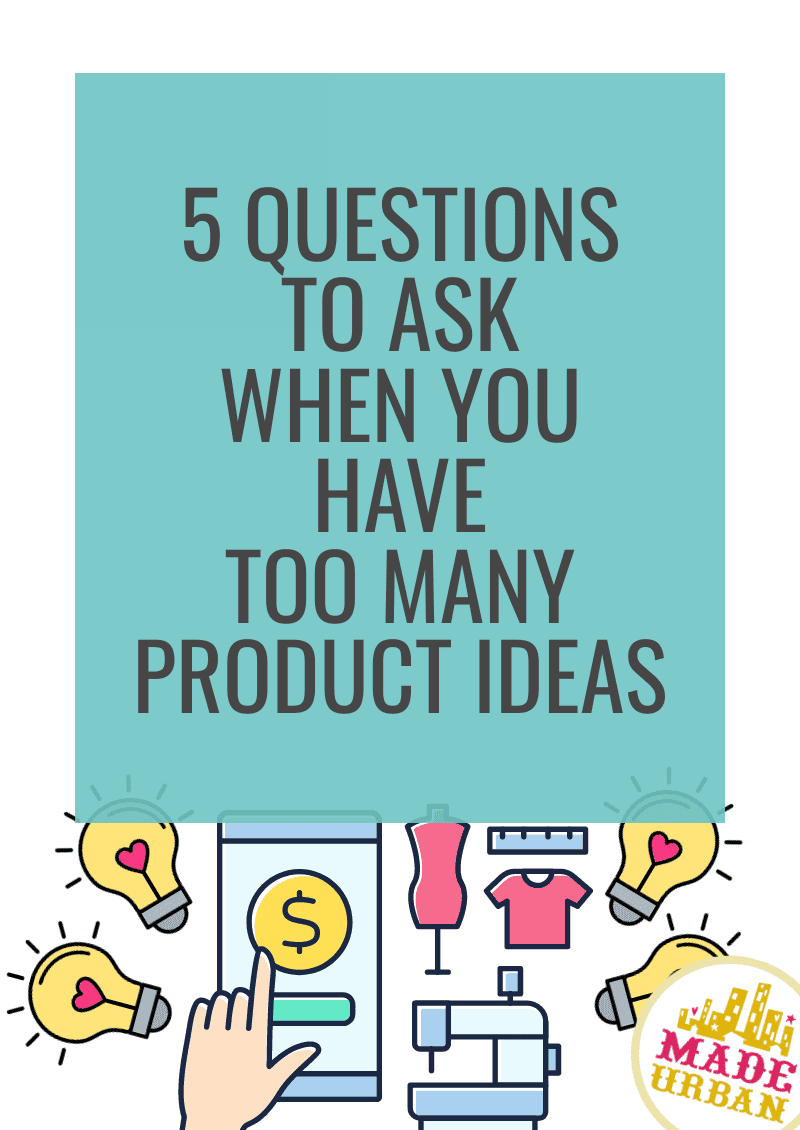5 Questions to Ask When You Have Too Many Product Ideas
One of the most common problems my readers struggle with, whether they know it or not, is choosing a direction.
They have too many product ideas, which is either preventing them from getting started or is hindering sales.
Whether your abundance of product ideas is due to your creativity and wanting to do “all of the things” or because you want to have options for everyone in hopes of selling to more people, it’s important to find a focus.
Here are 5 important questions to ponder before choosing a direction or adding another product to your business.
1 – Will it be profitable?
When you have many product ideas to choose from, or you’re ready to refine your product line but aren’t sure which products to cut, start with profit margins.
If you want to run a business, you need profits.
You might have an amazing product idea and that product may even sell like hotcakes. But if you can’t make it profitable, you won’t be able to run your business for very long.
There are some expenses you won’t know until you start making and selling a product. However, before you dive in, you should estimate how much it will cost to make an item (production time and materials), and the overhead expenses to prepare the product to sell, market it, and sell it.
Then research the price range consumers are expecting.
If the average price range for the product you’re thinking about selling is $20 – $40, but you won’t profit by setting your prices at $40, then it’s not a good product to sell (unless you can get your costs down).
If several of your products or product ideas have healthy profit margins, then consider the ones with the highest profit margins and use the next few questions to help you narrow things down.
2 – What’s in demand?
I’ve had a lot of “genius” product ideas that never sold. It doesn’t matter how great an idea is or how profitable a product can be; if consumers aren’t interested, you can’t build a business with it.
How do you know what’s in demand?
There isn’t a sure-fire way to know until you put your product out there.
However, you can gather hints from search engines, keyword search volumes, competitors, and reviews.
One of the simplest ways to check a product’s demand is to head to Etsy and search for the product you’re thinking about selling. Then look for shops that have the most reviews and check to see if the majority of reviews are for that type of product.
For example, let’s say I’m thinking about making golf headcovers.
I would search “golf headcovers” on Etsy and click on a few listings with hundreds or thousands of reviews.
On a listing’s page, I would first look to see if it states how many reviews the shop has for that specific item.

Then, I would visit the seller’s shop to see what type of items it’s filled with.
If the majority of the shop’s listings are for variations of that product (e.g. golf headcovers), that tells me the majority of their sales are likely for that item and it’s an in-demand product.
On the other hand, if the majority of the shop’s listings are for other types of products, their high sales/reviews aren’t necessarily for the product I’m thinking of selling.
I would check a few Etsy listings and shops this way to see if I can find a few businesses that seem to be having success selling the product I’m interested in.
If I can, those shops prove there’s demand for the product.
For more ways to check for demand before creating a product, check out: 5 Ways to Know if People will Buy your Handmade Product
3 – Can you make it stand out?
It’s unlikely you’re inventing a new product. So you’re going to have competition.
You need to consider if you can make the product you’re thinking of selling better or different from the options consumers already have.
There are many in-demand products, but when it comes to those items (e.g. jewelry, soap, candles, bags, etc.) consumers already have an abundance of options.
Too much competition can make it hard for a business to sell a popular product. It may also force a business to lower prices to make sales.
So once you find a profitable and in-demand product, consider if there’s a niche you can tap into or if you can make that product differently or better than the competition.
If we take the “golf headcovers” I’m thinking about sewing, I would explore:
- Niches – I might explore sub-sections of the “golf headcover” market to see if there’s a target market or product feature that’s being ignored or underserved. For example, a niche might be kid’s golf headcovers or golf headcovers for people who like to fish (“fish golf headcovers” is a commonly searched term). I might explore niches for golf headcovers based on fabric, color, type of club (e.g. driver, irons, hybrids, putter, etc.), or other product features.
- Better – I would consider if I could make a better version of what’s already out there and if consumers are likely to pay for the better version. It may be that Golf Town’s club headcovers are nice, but low quality. I may have an opportunity to make classic styles of golf headcovers in premium leather. Or perhaps another business is already targeting a popular niche such as “animal golf headcovers” but I think I can make a more realistic-looking animal golf headcover.
- Different – maybe I find that most golf headcovers are tricky to put on and take off and that a different type of opening might make it easier (e.g. golf headcovers that zip open and closed). Or I might make insulated golf headcovers for people who golf through the winter since a colder golf club reduces how far the ball will go. Or perhaps under a niche (animal golf headcovers), I have a different angle, such as “personalized animal golf headcovers” that are made-to-order to look like a golfer’s pet.
There are many ways to find niches within a category or type of product, but again, there must be demand.
I may find that no one is making animal print golf headcovers, but that doesn’t mean it’s a good product to make. Perhaps no one is making them because no one is searching for them.
My tried and true method for uncovering niches and checking demand is to use a keyword research tool (e.g. Moz, Ahrefs, Semrush, etc.) because they provide search volume and competition information.
However, if you don’t want to use a keyword research tool, one trick I like to use is a search engine’s auto-suggestion feature.
I start by entering a term, such as “golf headcovers”, on a search engine (e.g. Google, Etsy’s search bar, Pinterest’s search bar, etc.).
Before you hit “enter”, the search engine will often give suggestions. This is a good place to look for niches.

But you can also give the search engine a little more direction.
Add a space after your search term and enter one letter (e.g. “golf headcovers a”) and wait to see if you get more suggestions.
You may try adding the letter at the beginning, end, or somewhere within your search term to see if you get different results.
You can see on Google, that my results are slightly different when I add a “b” at the beginning of the search phrase or at the end.

You also want to check different spellings (e.g. golf headcovers vs gold head covers).
Just because a phrase shows up in the auto-suggestions doesn’t mean it has a “high” search volume. However, it does tend to indicate that it’s more commonly searched than a term.
4 – Is there room to expand?
An important aspect of a successful business is being able to keep customers and grow sales.
If I only sell golf headcovers, a customer is unlikely to return several months later to buy another golf headcover.
Or, if I sell a few golf headcovers and then the rest of my shop is filled with items unrelated to golf (e.g. bags, face masks, aprons, etc.), I don’t have anything for my target market (golfers) to come back and buy.
On the other hand, if I also sell golf towels, range finder cases, golf bag tags, golf cart seat covers, etc. I have several items golfers are interested in.
Can you think of, and make, other products that will work with the product you’re thinking of selling?
5 – What best showcases your talents?
To ensure sales, a business must put its target market first. However, your business must also incorporate you.
>> Where do you shine?
>> What do you love to do?
>> What’s your style?
You can’t let different target markets, or different segments of a target market, pull you in too many directions.
Let one target market guide you to a profitable niche product, then put your spin on it.
If I’ve decided I’m making golf headcovers, I could try to make a variety of options that appeal to different segments of the golfing target market. I could make:
- bright and colourful golf headcovers
- classic and minimalist golf headcovers
- funny golf headcovers
- leather and vegan golf headcovers
- etc.
But then I have a diluted product line that doesn’t represent me; the business owner.
My personal style incorporates classic elements, is more minimalistic and understated, and sticks to neutrals or earth tones.
So my product line should reflect that.
Trying to create a set of golf headcovers for someone who loves lots of color and attention-grabbing styles would be inauthentic and would likely fall flat because that’s not me and I can’t get into the heads of those customers.
Ensure a product idea isn’t pulling you in a direction that takes you outside your personal brand or style.


Hey, I’m Erin 🙂 I write about small business and craft show techniques I’ve learned from being a small business owner for almost 2 decades, selling at dozens of craft shows, and earning a diploma in Visual Communication Design. I hope you find my advice helpful!

Hi Erin,
I love your blog and devour everything you write. You have great insite in how to succeed as a vendor. I have two ideas for a craft show:
1. Totes and accessories.
2. Throw and floor pillows.
Both ideas are using the same type of fabrics. I want to set up 2 booths side-by-side with me running both OR set up 1 large booth with half bags and the other half pillows. What would you do? Do you recommend another option?
Thanks,
Terri
Hi Terri,
Thank you so much for reading and commenting! So glad you’re enjoying my content 🙂
That’s a great question. It sounds like there will be cohesion between the totes/accessories and throws/floor pillows, so if you’ll have enough space with one booth, it might make it easier on you to do that (and perhaps save you some money?). If you’re testing product ideas and aren’t sure what sells yet, you may want to choose the more budget-friendly option.
If you’re planning a more elaborate display, or one booth won’t give you enough room to separate the two product categories (1 – bags/accessories and 2 – home decor items), or if you plan on having a different look/feel/brand for each of the two categories of products, then it may be better to have two separate booths.
My recommendation, if you go with one booth, is to keep your product groupings tight (i.e. don’t mix pillows over on the bag side) and to have some negative/blank space between the two groupings so people shopping for bags can really focus on bags (and not get distracted by the pillows that will get them to start thinking about their home and decorating it).
To help you make a decision, think about:
-cost of booth(s)
-how much product you’ll have to sell to cover the cost of one booth versus two booths
-how much space you’ll need to display your products (without it looking crowded) or how much product you’ll need to fill two spaces (and if you have time to create that much product).
Also, if you do go with two booths, you’ll need more product; do you have a way of selling unsold product after the event?
I hope that helps!
~Erin